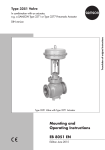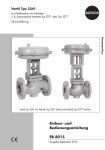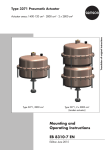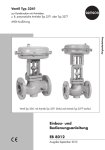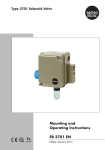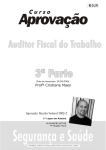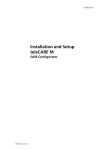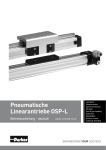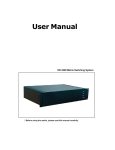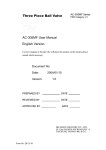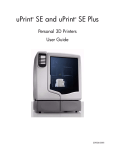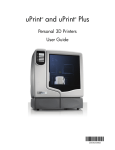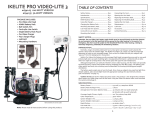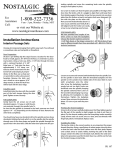Download Mounting and Operating Instructions EB 8015 EN
Transcript
Type 3241 Valve In combination with an actuator, e.g. a SAMSON Type 3271 or Type 3277 Pneumatic Actuator Translation of original instructions DIN version Type 3241 Valve with Type 3271 Actuator (left) and Type 3277 Actuator (right) Mounting and Operating Instructions EB 8015 EN Edition June 2015 Referenced documentation The following documents apply in addition to these mounting and operating instructions: −− Mounting and operating instructions for mounted actuator, e.g. u EB 8310‑X for Type 3271 and Type 3277 Actuators −− Mounting and operating instructions for mounted valve accessories (positioner, solenoid valve etc.) −− u AB 0100 for tools and lubricant The mounting and operating instructions for all supplied devices are included in the delivery. The latest versions of the documents are available on our website at u www.samson.de > Product documentation. Definition of signal words DANGER! Hazardous situations which, if not avoided, will result in death or serious injury WARNING! Hazardous situations which, if not avoided, could result in death or serious injury 2 NOTICE Property damage message or malfunction Note: Additional information Tip: Recommended action EB 8015 EN Contents 1 Safety instructions and safety measures..........................................................5 1.1 Notes on possible severe personal injury..........................................................7 1.2 Notes on possible personal injury....................................................................8 1.3 Notes on possible property damage.................................................................9 2 Markings on the control valve.......................................................................10 2.1 Valve nameplate...........................................................................................10 2.2 Actuator nameplate.......................................................................................11 2.3 Material number...........................................................................................11 3 Design and principle of operation.................................................................12 3.1 Fail-safe positions.........................................................................................14 3.2 Versions.......................................................................................................14 3.3 Technical data..............................................................................................15 4 Preparation..................................................................................................20 4.1 Unpacking...................................................................................................20 4.2 4.2.1 4.2.2 Transporting and lifting.................................................................................20 Transporting.................................................................................................21 Lifting...........................................................................................................21 4.3 Storage........................................................................................................24 4.4 Preparation for installation.............................................................................25 5 Mounting and start-up..................................................................................26 5.1 Mounting the actuator onto the valve..............................................................26 5.2 5.2.1 5.2.2 5.2.3 Installing the valve into the pipeline................................................................27 Checking the installation conditions................................................................27 Additional fittings..........................................................................................28 Installing the control valve..............................................................................29 5.3 Quick check.................................................................................................30 6 Operation....................................................................................................31 6.1 Working in manual mode..............................................................................31 7Maintenance................................................................................................32 7.1 7.1.1 7.1.2 Replacing the packing...................................................................................33 Standard valve versions.................................................................................33 Valves with insulating section or bellows seal..................................................33 EB 8015 EN 3 Contents 7.2 7.2.1 7.2.2 Replacing the seat.........................................................................................35 Standard valve versions.................................................................................35 Valves with insulating section or bellows seal..................................................35 7.3 7.3.1 7.3.2 Replacing the plug........................................................................................35 Standard valve versions.................................................................................35 Valves with insulating section or bellows seal..................................................35 7.4 Replacing the metal bellows (valves with insulating section or bellows seal only).37 7.5 Assembling the valve (valves with insulating section or bellows seal only)..........38 7.6 7.6.1 7.6.2 Replacing the seal.........................................................................................39 Standard valve versions.................................................................................39 Valves with insulating section or bellows seal..................................................40 7.7 Preparation for return shipment......................................................................40 7.8 Ordering spare parts and operating supplies..................................................40 8Malfunctions................................................................................................44 8.1 Troubleshooting............................................................................................44 8.2 Emergency action.........................................................................................45 9 Decommissioning and disassembly...............................................................45 9.1 Decommissioning..........................................................................................46 9.2 Removing the valve from the pipeline..............................................................46 9.3 Removing the actuator from the valve.............................................................46 9.4 Disposal.......................................................................................................46 10 Appendix.....................................................................................................48 10.1 Customer inquiries........................................................................................48 10.2 Certificates...................................................................................................49 10.3 Spare parts..................................................................................................55 4 EB 8015 EN Safety instructions and safety measures 1 Safety instructions and safety measures Intended use The SAMSON Type 3241 Globe Valve in combination with an actuator (e.g. Type 3271 or Type 3277 Pneumatic Actuator) is designed to regulate the flow rate, pressure or temperature of liquids, gases or vapors. The valve with its actuator is designed to operate under exactly defined conditions (e.g. operating pressure, process medium, temperature). Therefore, opera‑ tors must ensure that the control valve is only used in applications that meet the specifications used for sizing the valve at the ordering stage. In case operators intend to use the control valve in other applications or conditions than specified, SAMSON must be contacted. SAMSON does not assume any liability for damage resulting from the failure to use the valve for its intended purpose or for damage caused by external forces or any other external factors. ÎÎ Refer to the technical data and nameplate for limits and fields of application as well as possible uses. Reasonably foreseeable misuse The control valve is not suitable for the following applications: −− Use outside the limits defined during sizing and in the technical data −− Use outside the limits defined by the valve accessories mounted on the control valve Furthermore, the following activities do not comply with the intended use: −− Use of non-original spare parts −− Performing service and repair work not described in these instructions Qualifications of operating personnel The control valve must be mounted, started up, serviced and repaired by fully trained and qualified personnel only; the accepted industry codes and practices are to be observed. Ac‑ cording to these mounting and operating instructions, trained personnel refers to individuals who are able to judge the work they are assigned to and recognize possible hazards due to their specialized training, their knowledge and experience as well as their knowledge of the applicable standards. EB 8015 EN 5 Safety instructions and safety measures Personal protective equipment We recommend wearing the following protective equipment depending on the process medi‑ um: −− Protective clothing, gloves and eyewear in applications with hot, cold and/or corrosive media −− Wear hearing protection when working near the valve. ÎÎ Check with the plant operator for details on further protective equipment. Revisions and other modifications Revisions, conversions or other modifications to the product are not authorized by SAMSON. They are performed at the user's own risk and may lead to safety hazards, for example. Fur‑ thermore, the control valve may no longer meet the requirements for its intended use. Safety devices Upon supply air or control signal failure, the valve moves to its fail-safe position (see sec‑ tion 3.1). The fail-safe action of the actuator is the same as its direction of action and is spec‑ ified on the nameplate of SAMSON actuators (see actuator documentation). Warning against residual hazards To avoid personal injury or property damage, plant operators and operating personnel must prevent hazards that could be caused in the control valve by the process medium, the operat‑ ing pressure, the signal pressure or by moving parts by taking appropriate precautions. They must observe all hazard statements, warning and caution notes in these mounting and oper‑ ating instructions, especially for installation, start-up and maintenance. Responsibilities of the operator The operator is responsible for proper operation and compliance with the safety regulations. Operators are obliged to provide these mounting and operating instructions to the operating personnel and to instruct them in proper operation. Furthermore, operators must ensure that operating personnel or third persons are not exposed to any danger. Responsibilities of operating personnel Operating personnel must read and understand these mounting and operating instructions as well as the specified hazard statements, warning and caution notes. Furthermore, the operat‑ ing personnel must be familiar with the applicable health, safety and accident prevention regulations and comply with them. 6 EB 8015 EN Safety instructions and safety measures Referenced standards and regulations The control valves comply with the requirements of the European Pressure Equipment Direc‑ tive 97/23/EC. Valves with a CE marking have a declaration of conformity which includes information about the applied conformity assessment procedure. This declaration of confor‑ mity is included in the Appendix of these instructions (see section 10.2). According to the ignition risk assessment performed in accordance with EN 13463-1:2009, section 5.2, the non-electrical control valves do not have their own potential ignition source even in the rare incident of an operating fault. As a result, they do not fall within the scope of Directive 94/9/EC. ÎÎ For connection to the equipotential bonding system, observe the requirements specified in section 6.3 of EN 60079-14:2014-10 (VDE 0165 Part 1). 1.1 Notes on possible severe personal injury DANGER! Risk of bursting in pressure equipment. Control valves and pipelines are pressure equipment. Improper opening can lead to valve components bursting. ÎÎ Before starting any work on the control valve, depressurize all plant sections concerned and the valve. ÎÎ Drain the process medium from all the plant sections concerned as well as the valve. ÎÎ Wear personal protective equipment. EB 8015 EN 7 Safety instructions and safety measures 1.2 Notes on possible personal injury WARNING! Crush hazard arising from moving parts. The control valve contains moving parts (actuator and plug stems), which can in‑ jure hands or fingers if inserted into the valve. ÎÎ Do not insert hands or finger into the yoke while the valve is in operation. ÎÎ While working on the control valve, disconnect and lock the pneumatic air supply as well as the control signal. Risk of personal injury due to residual process medium in the valve. While working on the valve, residual process medium can escape and, depend‑ ing on its properties, may lead to personal injury, e.g. (chemical) burns. ÎÎ If possible, drain the process medium from all the plant sections concerned and the valve. ÎÎ Wear protective clothing, gloves and eyewear. Risk of burn injuries due to hot or cold components and pipelines. Depending on the process medium, valve components and pipelines may get very hot or cold and cause burn injuries. ÎÎ Allow components and pipelines to cool down or heat up. ÎÎ Wear protective clothing and gloves. Risk of personal injury due to preloaded springs. Valves in combination with pneumatic actuators with preloaded springs are un‑ der tension. These control valves with SAMSON pneumatic actuators can be identified by the long bolts protruding from the bottom of the actuator. ÎÎ Before starting any work on the actuator, relieve the compression from the preloaded springs (see associated actuator documentation). 8 EB 8015 EN Safety instructions and safety measures 1.3 Notes on possible property damage NOTICE Risk of valve damage due to contamination (e.g. solid particles) in the pipeline. ÎÎ Flush the pipelines before start-up. Risk of valve damage due to unsuitable medium properties. The valve is designed for a process medium with defined properties. ÎÎ Only use the process medium specified for sizing the valve. Risk of leakage and valve damage due to excessively high or low tightening torques. Observe the specified torques on tightening control valve components. Excessive‑ ly tightened torques lead to parts wearing out quicker. Parts that are too loose may cause leakage. ÎÎ Observe the specified tightening torques (u AB 0100). Risk of valve damage due to the use of unsuitable tools. Certain tools are require to work on the valve. ÎÎ Only use tools approved by SAMSON (u AB 0100). Risk of valve damage due to the use of unsuitable lubricants. The lubricants to be used depend on the valve material. Unsuitable lubricants may corrode and damage the valve surface. ÎÎ Only use lubricants approved by SAMSON (u AB 0100). EB 8015 EN 9 Markings on the control valve 2 Markings on the control valve 2.1 Valve nameplate 1 2 3 -4 5 7 9 11 12 6 8 10 13 14 15 Made in Germany SAMSON 1 CE marking or "Art. 3, Abs. 3", where applicable 2 ID of the notified body, fluid group and category, where applicable 3 Type designation 4 Device modification index 5 Material 6 Year of manufacture 7 Valve size: DIN: DN · ANSI: NPS · JIS: DN … A/B 8 Pressure rating: DIN: PN · ANSI: CL · JIS: K 9 Order no. with modification index 10 Position in order 11 Flow coefficient: DIN: KVS · ANSI: CV · JIS: CV 12 Characteristic: %: equal percentage · Lin: linear NO/NC: on/off service 13 Seat/plug seal: ME: metal (see section 3.3) HA: carbide metal ST: Stellite® facing KE: ceramic PT: soft seal with PTFE PK: soft seal with PEEK 14 Pressure balancing: DIN: D · ANSI: B · JIS: B 15 Flow divider: 1: St I · 3: St III Fig. 1: Valve nameplate 10 EB 8015 EN Markings on the control valve The valve nameplate (80) in nominal sizes DN 15 to 150 is affixed to the flange (Fig. 2). The valve nameplate in nominal sizes DN 200 and larger is located on the yoke (Fig. 3). 80 80 Fig. 2: Nameplate on the flange Fig. 3: Nameplate on the yoke 2.2 Actuator nameplate Seat code Material 01 1.4006 02 CrNiMo steel 03 1.4301 04 Stellite® 6B (CrNiMo steel with en‑ tire seat bore with Stellite facing) 05 Stellite® 6B (solid Stellite® seat) 10 1.4112 11 1.4306 12 1.4462 13 1.4539 14 1.7362 V 15 2.4360 16 2.4602 17 2.4605 18 2.4610 19 2.4617 20 2.4681 21 3.7035 22 3.7235 See associated actuator documentation. 2.3 Material number The seat and plug of the valves have an arti‑ cle number written on them. Specifying this article number, you can contact us to find out which material is used. Additionally, a seat code is used to identify the trim material. This seat code is specified on the nameplate (seat/plug seal, 13). For more details on the nameplate, see section 2.1. EB 8015 EN 11 Design and principle of operation 3 Design and principle of operation The single-seated Type 3241 Globe Valve is preferably combined with a SAMSON Type 3271 or Type 3277 Pneumatic Actuator (see Fig. 4). It can also be combined with other actuators. The seat (4) and plug with plug stem (5) are assembled in the body (1). The plug stem is connected to the actuator stem (A7) by the stem connector clamps (A26) and is sealed by a spring-loaded V-ring packing (16). The springs in the pneumatic actuator (A) are lo‑ cated either above or below the diaphragm depending on the selected fail-safe action (see section 3.1). A change in the signal pressure acting on the diaphragm causes the plug to move. The actuator size is deter‑ mined by the diaphragm area. 12 The medium flows through the valve in the direction indicated by the arrow. A rise in signal pressure causes the force acting on the diaphragm in the actuator to increase. The springs are compressed. Depending on the selected direction of action, the actuator stem retracts or extends. As a result, the plug position in the seat changes and determines the flow rate through the valve. EB 8015 EN Design and principle of operation Fig. 4: Type 3241‑1 Control Valve with Type 3271 Pneumatic Actuator, A body up to DN 150 A8 2 A7 84 A26 9 10 8 14 17 1 4 5 16 11 3 84 9 10 8 92 16 1 Body 2 Bonnet/flange 3 Yoke 4 Seat 5 Plug (with plug stem) 8 Threaded bushing 9 Stem connector nut 10 Lock nut 11 Spring 14 Nuts 16 Packing 17 Gasket 84 Travel indicator scale 92 Castellated nut A Actuator A7 Actuator stem A8 Ring nut A26 Stem connector clamps 11 14 2 17 1 5 4 EB 8015 EN Fig. 5: Type 3241 Valve, body DN 200 to 300 13 Design and principle of operation 3.1 Fail-safe positions 3.2 Versions The fail-safe position depends on the actua‑ tor used. The modular design allows an insulating sec‑ tion or metal bellows to be fitted to the stan‑ dard valve version. Depending on how the compression springs are arranged in the pneumatic actuator, the valve has two different fail-safe positions: Actuator stem extends When the signal pressure is reduced or the air supply fails, the springs move the actua‑ tor stem downward and close the valve. The valve opens when the signal pressure is in‑ creased enough to overcome the force exert‑ ed by the springs. Micro-flow valve version In the micro-flow valve version, a micro-trim element is installed in the valve body instead of the usual seat/plug assembly (Fig. 6). 5a 4a 4b 4c Actuator stem retracts When the signal pressure is reduced or the air supply fails, the springs move the actua‑ tor stem upwards and open the valve. The valve closes when the signal pressure is in‑ creased enough to overcome the force exert‑ ed by the springs. Tip: The actuator's direction of action can be reversed, if required. Refer to the mounting and operating instructions of the pneumatic actuator: u EB 8310‑X for Type 3271 and Type 3277 14 5b 4d 4a Seat body 4b Spring 4c Seat 4d Nut 5a Plug stem 5b Plug Fig. 6: Micro-trim element EB 8015 EN Design and principle of operation Actuators Temperature range In these instructions, the preferable combina‑ tion with a Type 3271 or Type 3277 Pneu‑ matic Actuator is described. The pneumatic actuator (with or without handwheel) can be replaced by another pneumatic actuator in a different size, but with the same travel. Depending on the version, the control valve is designed for a temperature range from –10 to +220 °C. The use of an insulating section or bellows seal extends the tempera‑ ture range from –196 to +450 °C. ÎÎ Observe the maximum permissible actu‑ ator force. Note: If the travel range of the actuator is larger than the travel range of the valve, the spring assembly in the actuator must be preloaded so that the travel ranges match. See associated actuator documentation. The basic pneumatic actuator can be re‑ placed by a pneumatic actuator with addi‑ tional handwheel or by an electric actuator. 3.3 Technical data The nameplates on the valve and actuator provide information on the control valve ver‑ sion. See section 2.1 and the actuator docu‑ mentation. Note: More information is available in Data Sheet u T 8015. Leakage class Depending on the version, the following leakage class applies: Seal (13 on nameplate) Pressure balancing (14 on nameplate) Leakage class (according to IEC 60534-4) ME, ST ME, ST PT, PK – D/B – Min. IV Min. IV VI Noise emission SAMSON is unable to make general state‑ ments about noise emission as it depends on the valve version, plant facilities and process medium. On request, SAMSON can perform calculations according to IEC 60534, Part 8-3 or VDMA 24422 (edition 89). WARNING! Risk of hearing loss or deafness due to loud noise. Wear hearing protection when working near the valve. Compliance The Type 3241 Valve bears both the CE and EAC marks of conformity. EB 8015 EN 15 Design and principle of operation Dimensions and weights Table 1 to Table 3 provide a summary of the dimensions and weights of the standard version of Type 3241 Valve. Table 4 and Table 5 show the dimensions and weights for the Type 3241 Valve with insulating section or bellows seal. Dimensions in mm · Weights in kg Table 1: Dimensions of Type 3241 Valve, up to DN 150 Valve DN 15 20 25 32 40 50 65 80 100 125 150 Length L mm 130 150 160 180 200 230 290 310 350 400 480 354 363 390 413 423 450 118 144 175 ≤ 750 cm² H1 for actuator H2 for 222 223 1000 cm² 1400-60 cm² – 1400-120 cm² 2800 cm² – Cast steel Forged steel 262 44 53 – 72 70 – 92 98 98 – 128 – Table 2: Dimensions of Type 3241 Valve, DN 200 and larger Valve DN 200 250 Cast iron 250 Up to 200 mm seat bore 250 seat bore 250 mm and larger 300 Length L mm 600 730 730 730 850 H4 mm 390 390 451 451 652 1000 cm² 1400-60 cm² 418 418 418 503 503 1400-120 cm² 2800 cm² 503 503 503 650 650 mm 245 270 310 310 370 H8 1) for actuator H2 1) H8 increases by 170 mm for valves with KVS 250, 360 or 630 and 60 mm rated travel operating with overtravel. 16 EB 8015 EN Design and principle of operation Table 3: Weights for Type 3241 Valve Valve Weight DN 15 20 25 32 40 50 65 80 100 125 150 200 250 cast iron 250 300 kg 6 7.5 8 12 14 18 29 34 52 81 108 430 468 858 920 Dimensional drawings H8 H1 H4 H2 H2 L Type 3241 · DN 15 to 150 EB 8015 EN L Type 3241 · DN 200 to 300 17 Design and principle of operation Table 4: Dimensions and weights for the Type 3241 Valve with insulating section or bellows seal up to DN 150 Nominal size DN 15 20 25 32 40 50 65 80 100 125 150 Insulating section or bellows seal ≤750 cm² H4 for actuator 1000 cm² 1400-60 cm² 1400120 cm² 2800 cm² Weight (approx. kg) Short 409 410 451 636 645 672 Long 713 714 755 877 886 913 Short – 695 705 732 Long – 936 946 973 Short Long – Short/with bellows 9 10.5 11 18 20 24 37 42 70 106 138 Long/with bellows 13 14.5 15 22 24 28 41 46 78 114 146 Table 5: Dimensions and weights for the Type 3241 Valve with insulating section or bellows seal for DN 200 and larger Version with Insulating section 200 250 (cast iron) 830 830 1065 1000 cm² 1400-60 cm² 418 418 1400-120 cm² 2800 cm² 503 503 Valve DN Height H4 mm H8 for actuator Weight (approx. kg) 18 250 250 Up to 250 mm 200 mm seat seat bore bore 478 Bellows seal 250 250 Up to 250 mm 200 mm seat seat bore bore 300 200 250 (cast iron) 1065 1150 1036 1036 1492 1492 1520 418 503 503 418 418 418 503 503 503 650 650 503 503 503 650 650 963 520 928 975 300 1010 EB 8015 EN Design and principle of operation Dimensional drawings H8 H4 H4 Type 3241 with insulating section or bellows seal · DN 15 to 150 Type 3241 with insulating section or bellows seal · DN 200 to 300 Note: Refer to the following data sheets for more dimensions and weights: u T 8015 for valves with bellows seal, insulating section or heating jacket The associated actuator documentation applies to actuators, e.g. for SAMSON pneumatic actuators: u T 8310‑1 for Type 3271 and Type 3277 Actuators up to 750 cm² actuator area u T 8310‑2 for Type 3271 Actuator with 1000 cm² actuator area and larger as well as Type 3273 Actuator u T 8310‑3 for Type 3271 Actuator with 1400-60 cm² actuator area EB 8015 EN 19 Preparation 4 Preparation After receiving the shipment, proceed as fol‑ lows: 1. Check the scope of delivery. Compare the shipment received against the deliv‑ ery note. 2. Check the shipment for transportation damage. Report any damage to SAM‑ SON and the forwarding agent (refer to delivery note). 4.1 Unpacking Note: Do not remove the packaging until immediately before installing the valve into the pipeline. Proceed as follows to lift and install the valve: 1. Remove the packaging from the valve. 2. Dispose of the packaging in accordance with the valid regulations. NOTICE Risk of valve damage due to foreign particles entering the valve. The protective caps fitted on the valve's inlet and outlet prevent foreign particles from entering the valve and damaging it. Do not remove the protective caps until immediately before installing the valve into the pipeline. 20 4.2 Transporting and lifting DANGER! Hazard due to suspended loads falling. Stay clear of suspended or moving loads. WARNING! Risk of lifting equipment tipping and risk of damage to lifting accessories due to exceeding the rated lifting capacity. −−Only use approved lifting equipment and accessories whose minimum lifting capacity is higher than the weight of the valve (including actuator, if applicable). −−Refer to section 3.3 or Data Sheet u T 8015 for weights. WARNING! Risk of personal injury due to control valve tipping. −−Observe the valve's center of gravity. −−Secure the valve against tipping over or turning. EB 8015 EN Preparation NOTICE Risk of valve damage due to incorrectly attached slings. The lifting eyelet on the actuator is only intended for mounting and removing the actuator as well as lifting the actuator without valve. Do not use this lifting eyelet to lift the entire control valve assembly. −−When lifting the control valve, make sure that the slings attached to the valve body bear the entire load. −−Do not attach load-bearing slings to the actuator, handwheel or any other parts. −−Observe lifting instructions (see section 4.2.2). Tip: SAMSON's After-sales Service department can provide more detailed transport and lifting instructions on request. 4.2.1 Transporting The control valve can be transported using lifting equipment (e.g. crane or forklift). ÎÎ Leave the control valve in its transport container or on the pallet to transport it. ÎÎ Observe the transport instructions. Transport instructions −− Protect the control valve against external influences (e.g. impact). −− Do not damage the corrosion protection (paint, surface coatings). Remove any damage immediately. −− Protect the control valve against moisture and dirt. −− The permissible transportation tempera‑ ture of standard control valves is –20 to +65 °C. Note: Contact SAMSON's After-sales Service department for the transportation temperatures of other valve versions. 4.2.2 Lifting To install a large valve into the pipeline, use lifting equipment (e.g. crane or forklift) to lift it. Lifting instructions −− Secure slings against slipping. −− Make sure the slings can be removed from the valve once it has been installed into the pipeline. EB 8015 EN 21 Preparation −− Prevent the control valve from tilting or tipping. −− Do not leave loads suspended when in‑ terrupting work for longer periods of time. than DN 150. The sling only protects the control valve from tilting while being lift‑ ed. Before lifting the control valve, tight‑ en the sling. −− Make sure that the axis of the pipeline is always horizontal during lifting and the axis of the plug stem is always vertical. −− Make sure that the additional sling be‑ tween the lifting eyelet and rigging equipment (hook, shackle etc.) does not bear any load when lifting valves larger  Fig. 7: Lifting points on the control valve: up to DN 150 (left) and with welding ends (middle) DN 150 and larger with additional lifting eyelet on the actuator (right) 22 EB 8015 EN Preparation Version with flanges Version with welding ends 1. Attach one sling to each flange of the body and to the rigging equipment (e.g. hook) of the crane or forklift (see Fig. 7). 1. Attach one sling to each welding end of the body and to the rigging equipment (e.g. hook) of the crane or forklift (see Fig. 7). 2. DN 150 and larger: Attach another sling to the lifting eyelet on the actuator and to the rigging equipment. 2. Secure the slings attached to the body against slipping using a connector. 3. Carefully lift the control valve. Check whether the lifting equipment and acces‑ sories can bear the weight. 3. DN 150 and larger: Attach another sling to the lifting eyelet on the actuator and to the rigging equipment. 4. Move the control valve at an even pace to the site of installation. 4. Carefully lift the control valve. Check whether the lifting equipment and acces‑ sories can bear the weight. 5. Install the valve into the pipeline (see sec‑ tion 5.2.3). 6. After installation in the pipeline, check whether the flanges are bolted tight and the valve in the pipeline holds. 7. Remove slings. 5. Move the control valve at an even pace to the site of installation. 6. Install the valve into the pipeline (see sec‑ tion 5.2.3). 7. After installation in the pipeline, check whether the weld seams hold. 8. Remove connector and slings. Tip: We recommend using a hook with safety latch (see Fig. 7). The safety latch prevents the slings from slipping during lifting and transporting. EB 8015 EN 23 Preparation 4.3 Storage NOTICE Risk of valve damage due to improper storage. −−Observe storage instructions. −−Avoid long storage times. −−Contact SAMSON in case of different storage conditions or longer storage times. Note: We recommend regularly checking the control valve and the prevailing storage conditions during long storage times. less than 75 %. In damp spaces, prevent condensation. If necessary, use a drying agent or heating. −− Make sure that the ambient air is free of acids or other corrosive media. −− The permissible storage temperature of standard control valves is –20 to +65 °C. Note: Contact SAMSON's After-sales Service department for the storage temperatures of other valve versions. −− Do not place any objects on the control valve. −− Pack the control valve in airtight packag‑ ing. Storage instructions Special storage instructions for soft parts −− Valves in DN 100 and smaller can be stored horizontally. Soft parts, e.g. actuator diaphragm Store valves larger than DN 150 in the upright position with the actuator on top to avoid damage to the seals (packing chamber and pressure balancing). −− If valves in DN 50 or larger are stored in one place for longer than six months, store them in the upright position with the actuator on top. −− Protect the control valve against external influences (e.g. impact). −− Do not damage the corrosion protection (paint, surface coatings). Remove any damage immediately. −− Protect the control valve against moisture and dirt. Store it at a relative humidity of 24 −− To protect soft parts against UV light and ozone, pack them in black plastic bags. We recommend using polyethylene pack‑ aging with a minimum thickness of 0.075 mm. Do not use PVC. −− To keep soft parts in shape and to pre‑ vent cracking, do not bend them or hang them up. −− We recommend a storage temperature of 15 °C for soft parts. −− Store soft parts away from lubricants, chemicals, solutions and fuels. Tip: SAMSON's After-sales Service department can provide more detailed storage instructions on request. EB 8015 EN Preparation 4.4 Preparation for installation Proceed as follows: ÎÎ Flush the pipelines. ÎÎ Check the valve to make sure it is clean. ÎÎ Check the valve for damage. ÎÎ Check to make sure that the type desig‑ nation, nominal size, material, pressure rating and temperature range of the valve match the plant conditions (size and pressure rating of the pipeline, me‑ dium temperature etc.). ÎÎ For steam applications, make sure that the pipelines are dry. Moisture will dam‑ age the inside of the valve. ÎÎ Check any mounted pressure gauges to make sure they function. ÎÎ When the valve and actuator are al‑ ready assembled, check the tightening torques of the bolted joints (u AB 0100). Components may loosen during trans‑ port. EB 8015 EN 25 Mounting and start-up 5 Mounting and start-up SAMSON valves are delivered ready for use. In special cases, the valve and actuator are delivered separately and must be assem‑ bled on site. The procedure to mount and start up the valve are described in the follow‑ ing. NOTICE Risk of valve damage due to excessively high or low tightening torques. Observe the specified torques on tightening control valve components. Excessively tightened torques lead to parts wearing out quicker. Parts that are too loose may cause leakage. Observe the specified tightening torques (u AB 0100). Note: −−Remove the mounted actuator before mounting the other actuator (see associated actuator documentation). −−Preloading the actuator springs increases the thrust of a pneumatic actuator and reduces the travel range of the actuator (see associated actuator documentation). −−DN 100 and larger: in versions with V‑port plug, the large V-shaped port of the V-port plug must face towards the valve outlet on mounting the actuator. NOTICE Risk of valve damage due to the use of unsuitable tools. Only use tools approved by SAMSON (u AB 0100). 5.1 Mounting the actuator onto the valve Proceed as described in the actuator docu‑ mentation if the valve and actuator have not been assembled by SAMSON: 26 EB 8015 EN Mounting and start-up 5.2 Installing the valve into the pipeline 5.2.1 Checking the installation conditions Pipeline routing The inlet and outlet lengths vary depending on the process medium. To ensure the control valve functions properly, follow the installa‑ tion instructions given below: ÎÎ Observe the inlet and outlet lengths (see Table 6). Contact SAMSON if the valve conditions or states of the medium pro‑ cess deviate. ÎÎ Install the valve free of stress and with the least amount of vibrations as possible. If necessary, attach supports to the valve. ÎÎ Install the valve allowing sufficient space to remove the actuator and valve or to perform service and repair work on them. Table 6: Inlet and outlet lengths Q Q a b a x DN State of process medium Flow rate Inlet length Outlet length b x DN Inlet length a Outlet length b 2 4 0.3 ≤ Ma ≤ 0.7 2 10 Ma ≤ 0.3 1) 2 4 0.3 ≤ Ma ≤ 0.7 1) 2 10 Saturated steam (percentage of condensate > 5 %) 2 20 Free of cavitation/w < 10 m/s 2 4 Cavitation producing noise/w ≤ 3 m/s 2 4 Cavitation producing noise/3 < w < 5 m/s 2 10 Critical cavitation/w ≤ 3 m/s 2 10 Critical cavitation/3 < w < 5 m/s 2 20 Flashing – 2 20 Multi-phase – 10 20 Gas Vapor Liquid 1) Valve conditions Ma ≤ 0.3 No saturated steam EB 8015 EN 27 Mounting and start-up Mounting position We recommend installing the valve upright with the actuator on top. Valves, which are not installed in the pipe‑ line in the upright position with the actuator on top, must be supported or suspended. The deadweight of the control valve may lead to premature wear or leakage if it is not supported or suspended. In the following versions, the valve must be installed in the upright position with the actu‑ ator on top. −− Valves in DN 100 and larger −− Valves with insulating section for low temperatures below –10 °C ÎÎ Contact SAMSON if the mounting posi‑ tion is not as specified here. Vent plugs Vent plugs are screwed into the exhaust air ports of pneumatic, electropneumatic and electric devices. They ensure that any ex‑ haust air that forms can be vented to the at‑ mosphere (to avoid excess pressure in the device). Furthermore, the vent plugs allow air intake to prevent a vacuum from forming in the device. ÎÎ Locate the vent plug on the opposite side to the workplace of operating personnel. ÎÎ On mounting valve accessories, make sure that they can be operated from the workplace of the operating personnel. 28 Note: The workplace of operating personnel is the location from which the valve, actuator and any mounted valve accessories can be accessed to operate them. 5.2.2 Additional fittings Strainer We recommend installing a SAMSON Type 2 Strainer upstream of the valve. It pre‑ vents solid particles in the process medium from damaging the valve. Bypass and shut-off valves We recommend installing a shut-off valve both upstream of the strainer and down‑ stream of the valve and setting up a bypass line. The bypass line ensures that the plant does not need to be shut down for service and repair work on the valve. Insulation Only insulate control valves with insulating section or bellows seal up to the bonnet flange of the valve body for medium tem‑ peratures below 0 °C or above 220 °C. Do not insulate valves mounted to comply with NACE MR 0175 requirements. EB 8015 EN Mounting and start-up Test connection Versions with bellows seal fitted with a test connection (G 1/8) at the top flange allow the tightness of the bellows to be monitored. Particularly for liquids and vapors, we rec‑ ommend installing a suitable leakage indica‑ tor (e.g. a contact pressure gauge, an outlet to an open vessel or an inspection glass). WARNING! Risk of personal injury due to components under pressure and process medium escaping under pressure. Do not loosen the screw of the test connection while the valve is in operation. Safety guard To reduce the crush hazard arising from moving parts (actuator and plug stem), a safety guard can be installed. Noise emission Trims with flow dividers can be used to re‑ duce noise emission (see u T 8081). 5.2.3 Installing the control valve tion 4.2.2). Observe the flow direction through the valve. The arrow on the valve indicates the direction of flow. 4. Make sure that the correct flange gaskets are used. 5. Bolt the pipe to the valve free of stress. 6. Depending on the field of application, allow the valve to cool down or heat up to reach ambient temperature before start up. 7. Slowly open the shut-off valve in the pipeline after the valve has been in‑ stalled. NOTICE Risk of valve damage due to a sudden pressure increase and resulting high flow velocities. Slowly open the shut-off valve in the pipeline during start-up. 8. Check the valve to ensure it functions properly and that there is no leakage. Version with welding ends 1. Proceed as described for Version with flanges (steps 1 to 3). Version with flanges 2. Completely retract the actuator stem to protect the plug from sparks during weld‑ ing. 1. Close the shut-off valve in the pipeline while the valve is being installed. 3. Weld the valve free of stress into the pipeline. 2. Remove the protective caps from the valve ports before installing the valve. 4. Proceed as described for Version with flanges (steps 6 to 8). 3. Lift the valve using suitable lifting equip‑ ment to the site of installation (see sec‑ EB 8015 EN 29 Mounting and start-up 5.3 Quick check SAMSON valves are delivered ready for use. To test the valve's ability to function, the following quick checks can be performed: Packing For versions with adjustable packing (Form H), check whether the packing is correctly tightened to prevent process medium escap‑ ing during start-up. Tip: A label on the bonnet/flange (2) or yoke (3) indicates whether an adjustable packing is installed. ÎÎ Slightly turn the packing nut clockwise with a suitable tool to tighten the pack‑ ing. Travel motion The movement of the actuator stem must be linear and smooth. ÎÎ Open and close the valve, observing the movement of the actuator stem. ÎÎ Apply the maximum and minimum con‑ trol signals to check the end positions of the valve. ÎÎ Check the travel reading at the travel in‑ dicator scale. Fail-safe position ÎÎ Shut off the signal pressure line. ÎÎ Check whether the valve moves to the fail-safe position. 30 EB 8015 EN Operation 6 Operation Immediately after completing mounting and start-up (see section 5), the valve is ready for use. WARNING! Crush hazard arising from moving parts (actuator and plug stem). Do not insert hands or finger into the yoke while the valve is in operation. NOTICE Operating disturbed by a blocked actuator and plug stem. Do not impede the movement of the actuator or plug stem by inserting objects into their path. 6.1 Working in manual mode Valves fitted with actuators with a handwheel can be manually closed or opened in case of supply air failure. ÎÎ For normal closed-loop operation, move the handwheel to the neutral position. EB 8015 EN 31 Maintenance 7 Maintenance The control valve is subject to normal wear, especially at the seat, plug and packing. De‑ pending on the operating conditions, check the valve at regular intervals to prevent pos‑ sible failure before it can occur. Tip: SAMSON's After-sales Service department can support you to draw up a maintenance plan for your plant. External leakage can indicate that the pack‑ ing is defective or the metal bellows is defec‑ tive (in a version with a bellows seal). If the valve does not close tightly, tight shutoff may be impaired by dirt stuck between the seat and plug or by damaged facings. We recommend removing the valve from the pipeline or service or repair work (see sec‑ tion 9.2). Remove the affected parts as de‑ scribed, carefully clean them and renew them, if necessary. DANGER! Risk of bursting in pressure equipment. Control valves and pipelines are pressure equipment. Improper opening can lead to bursting of the valve. −−Before starting any work on the control valve, depressurize all plant sections concerned and the valve. −−Drain the process medium from all the plant sections concerned as well as the valve. 32 −−Wear personal protective equipment. WARNING! Risk of personal injury due to residual process medium in the valve. While working on the valve, residual process medium can escape and, depending on its properties, may lead to personal injury, e.g. (chemical) burns. Wear protective clothing, gloves and eyewear. WARNING! Risk of burn injuries due to hot or cold components and pipeline. Valve components and the pipeline may become very hot or cold. Risk of burn injuries. −−Allow components and pipelines to cool down or heat up. −−Wear protective clothing and gloves. NOTICE Risk of valve damage due to excessively high or low tightening torques. Observe the specified torques on tightening control valve components. Excessively tightened torques lead to parts wearing out quicker. Parts that are too loose may cause leakage. Observe the specified tightening torques (u AB 0100). EB 8015 EN Maintenance NOTICE Risk of valve damage due to the use of unsuitable tools. Only use tools approved by SAMSON (u AB 0100). NOTICE Risk of valve damage due to incorrect maintenance or repair. −−Service and repair work must only be performed by trained staff. −−Contact SAMSON's After-sales Service department for service and repair work. 7.1 Replacing the packing 9. Remove the gasket (17) and carefully clean sealing faces in the valve body (1) and on the bonnet (2). 10.Apply a suitable lubricant to all the pack‑ ing parts and to the plug stem (5). 11.Slide the plug with plug stem (5) into the valve body (1). 12.Insert a new gasket (17) into the body. 13.Version with V-port plug: place the valve bonnet (2) onto the valve body, making sure that the largest V-shaped port of the V-port plug faces towards the valve out‑ let. Fasten with nuts (14). 14.Carefully slide the packing parts over the plug stem into the packing chamber. Make sure you observe the proper order (see Fig. 8). 7.1.1 Standard valve versions 15.Screw in the threaded bushing (8) and tighten it. 1. Remove actuator. See associated actua‑ tor documentation. 16.Loosely screw the lock nut (10) and stem connector nut (9) onto the plug stem. 2. Remove body nuts (14). 17.Mount actuator. See associated actuator documentation. 3. Lift the valve bonnet (2) and plug with plug stem (5) off the body (1). 4. Unthread the stem connector nut (9) and lock nut (10) from the plug stem. 5. Unscrew the threaded bushing (8). 18.Adjust lower or upper signal bench range. See associated actuator docu‑ mentation. 6. Pull the plug with plug stem (5) out of the valve bonnet (2). 7.1.2 Valves with insulating section or bellows seal 7. Pull all the packing parts out of the pack‑ ing chamber using a suitable tool. 1. Remove actuator. See associated actua‑ tor documentation. 8. Renew damaged parts. Clean the pack‑ ing chamber thoroughly. 2. Unthread the stem connector nut (9) and lock nut (10) from the plug stem exten‑ sion (25). EB 8015 EN 33 Maintenance 3. Unscrew the threaded bushing (8). 4. Remove nuts (33) and bolts (32). 5. Carefully lift the valve bonnet (2) over the plug stem extension (25). 6. Pull all the packing parts out of the pack‑ ing chamber using a suitable tool. 7. Renew the damaged parts and carefully clean the packing chamber. 8. Remove the gasket (17) in the bellows seal (22) and carefully clean the sealing faces. 9. Apply a suitable lubricant to all the pack‑ ing parts and to the plug stem extension. 10.Insert a new gasket (17) into the body. 11.Carefully lift the bonnet (2) over the plug stem extension (25) onto the bellows seal (22). Fasten with nuts (33) and bolts (32). 12.Carefully slide the packing parts over the plug stem extension into the packing chamber. Make sure you observe the proper order (see Fig. 8). 13.Screw in the threaded bushing (8) and tighten it. 14.Loosely screw the lock nut (10) and stem connector nut (9) onto the plug stem. 15.Mount actuator. See associated actuator documentation. 8 16 12 11 2 5 2 Valve bonnet 3 Yoke 5 Plug with plug stem 8 Threaded bushing 11 Spring 12 Washer 16 Packing rings 25 Plug stem extension Fig. 8: Packing in standard valves, DN 15 to 150 34 EB 8015 EN Maintenance 16.Adjust lower or upper signal bench range. See associated actuator docu‑ mentation. 7.2 Replacing the seat When exchanging the seat, we recommend also checking the plug and packing and to replace them as well, if necessary. 7.2.1 Standard valve versions 1. To replace the seat, proceed as described in section 7.1.1, items 1 to 7. 2. Unscrew the seat using a suitable seat wrench (u AB 0100). 3. Apply a suitable lubricant to the thread and the sealing cone of the new seat. 4. Screw in the seat. 7.2.2 Valves with insulating section or bellows seal 1. To replace the seat, proceed as described in section 7.1.2, items 1 to 6. 2. Unscrew the seat using a suitable seat wrench (u AB 0100). 3. Apply a suitable lubricant to the thread and the sealing cone of the new seat. 4. Screw in the seat. 7.3 Replacing the plug When exchanging the plug, we recommend also checking the seat and packing and to replace them as well, if necessary. EB 8015 EN 7.3.1 Standard valve versions ÎÎ To replace the plug, proceed as de‑ scribed in section 7.1.1, items 1 to 18. Replace the old plug with a new plug. 7.3.2 Valves with insulating section or bellows seal Proceed for valves in DN 15 to 150 To unscrew the plug (5) from the plug stem extension (25), screw two nuts onto the pro‑ truding thread of the extension to hold the plug stem extension stationary. NOTICE To prevent damage in the valve with bellows seal, make sure that no torque is transferred to the metal bellows, which is welded onto the plug stem. We recommend using a clamping tool (u AB 0100). A valve with insulating section does not contain a bellows. 1. Remove actuator. See associated actua‑ tor documentation. 2. Remove body nuts (14). 3. Lift the bellows seal (22) together with the plug stem extension (25), plug stem and plug (5) out of the valve body. 4. Remove gasket (17). 5. Carefully clean the sealing faces of the gasket in the valve body and on the in‑ termediate piece. 6. Use a wrench to hold the nuts screwed onto the plug stem extension stationary. 35 Maintenance 2 9 10 8 25 15 39 33 DN 200 to 300 (with flow divider) 42 41 9 22 3 DN 15 to 150 (forged steel body) 37 15 30 42 14 101 32 37 39 17 22 14 28 34 27 29 Fig. 9: Valves with insulating section or bellows seal 36 EB 8015 EN Maintenance 7. Clamp the plug stem with a suitable tool and screw it out of the plug stem exten‑ sion without twisting the metal bellows. metal bellows (37), which is welded onto the plug stem, cannot be twisted. 8. Apply a suitable lubricant to the end of the plug stem of the new plug (5). 6. Screw a new plug (29) with clamping ring (28) and flange (27) onto the plug stem. 9. Check whether the two washers (30) are still in the plug stem extension (25). 7. Continue assembly as described in sec‑ tion 7.5. 10.Screw the plug stem tightly into the plug stem extension (25) (see u AB 0100 for tightening torques). 11.Continue assembly as described in sec‑ tion 7.5. Proceed for valves in DN 200 to 300 1. Remove actuator. See associated actua‑ tor documentation. 2. Remove body nuts (14). 3. Lift bellows seal (22) together with the bellows bonnet (101) and plug stem with metal bellows (37) off the valve body. 4. Remove screws (34), clamping ring (28) and flange (27). 5. Unscrew the plug (29) from the plug stem using a suitable clamping tool to hold the plug stem stationary to ensure that the Note: The parts (27), (28) and (34) are not used in the version with insulating section. The plug and plug stem form one piece. 7.4 Replacing the metal bellows (valves with insulating section or bellows seal only) Proceed for valves in DN 15 to 150 1. Remove actuator. See associated actua‑ tor documentation. 2. Remove body nuts (14). 2 Valve bonnet 22 Bellows seal 33 Nut 3 Yoke 25 Plug stem extension 34 Screw 8 Threaded bushing 27 Flange 37 Plug stem with bellows 9 Stem connector nut 28 Clamping ring 39 Gasket 10 Lock nut 29 41 Nut 14 Body nut Plug for version with bellows seal Packing Washers Test connection 15 30 42 Screw Bellows bonnet Gasket 32 101 17 EB 8015 EN 37 Maintenance 3. Lift the bellows seal (22) together with the plug stem extension (25), plug stem and plug (5) out of the valve body. 4. Use a wrench to hold the nuts screwed onto the plug stem extension stationary. 5. Clamp the plug stem with a suitable tool and screw it out of the plug stem exten‑ sion without twisting the metal bellows. 6. Unscrew the nut (41) using a SAMSON socket wrench (u AB 0100). 7. Pull the plug stem extension with the met‑ al bellows (37) welded onto it out of the bellows seal (22). 8. Clean the sealing faces on the bellows seal (22). 9. Slide the new metal bellows (37) into the bellows seal (22). Firmly screw in the nut (41) without twisting the metal bellows. 10.Check whether the two washers (30) are still in the plug stem extension (25). 5. Unscrew the plug (29) from the plug stem using a suitable clamping tool to hold the plug stem stationary to ensure that the metal bellows (37), which is welded onto the plug stem, cannot be twisted. 6. Renew the seal (39) and insert the new plug stem with metal bellows (37). 7. Screw a new plug (29) with clamping ring (28) and flange (27) onto the plug stem. 8. Continue assembly as described in sec‑ tion 7.5. 7.5 Assembling the valve (valves with insulating section or bellows seal only) After replacing parts, assembly the valve as follows: 1. Insert the new gasket (17) into the body. Proceed for valves in DN 200 to 300 2. Place the bellows seal (22) onto the valve body (1). Version with V-port plug: place the bel‑ lows seal (22) onto the valve body, mak‑ ing sure that the largest V-shaped port of the V-port plug faces towards the valve outlet. 1. Remove actuator. See associated actua‑ tor documentation. 3. Fasten the bellows seal (22) with nuts (14). 2. Remove body nuts (14). 4. Insert a new gasket (39) into the bellows seal. 11.Apply a suitable lubricant to the thread of the plug stem. 12.Screw the plug stem tightly into the plug stem extension (25) (see u AB 0100 for tightening torques). 3. Lift bellows seal (22) together with the bellows bonnet (101) and plug stem with metal bellows (37) off the valve body. 4. Remove screws (34), clamping ring (28) and flange (27). 38 5. Place the valve bonnet (2) or bellows bonnet (101) onto the bellows seal (22) and fasten tight using the nuts (33) and bolts (32). Observe tightening torques listed in u AB 0100. EB 8015 EN Maintenance 6. Screw in the threaded bushing (8) and tighten it. 8. Push out the bushing (51) and renew the seal (45). 7. Loosely screw the lock nut (10) and stem connector nut (9) onto the plug stem ex‑ tension (25) or plug stem with metal bel‑ lows (37). 9. Clean the packing chamber thoroughly. 8. Mount actuator. See associated actuator documentation. 9. Adjust lower or upper signal bench range. See associated actuator docu‑ mentation. 7.6 Replacing the seal 10.Apply a suitable lubricant to the bushing (51) and press it in. 11.Apply a suitable lubricant to the packing parts, plug stem (5) and the face of the seal (45). 12.Slide the plug with plug stem (5) into the valve bonnet. 13.Continue as described in Continued as‑ sembly. Proceed for valves in DN 50 to 150 7.6.1 Standard valve versions 7. Remove screw (49) with lock (50) and washer (52). Renew the seal (45). Procedure for version with balanced plug 8. Insert washer (52). 1. Unthread the stem connector nut (9) and lock nut (10) from the plug stem. 9. Insert screw (49) with lock (50) and screw tight. 2. Remove body nuts (14). 10.Apply a suitable lubricant to the packing parts, plug stem (5) and the face of the seal (45). 3. Carefully lift off the valve bonnet (2) and plug with plug stem (5). 4. Unscrew the threaded bushing (8) and pull the plug with plug stem (5) out of the bonnet. 5. Remove gasket (17). 6. Carefully clean the sealing faces in the valve body and on the bonnet. Proceed for valves in DN 40 7. Pull the packing (16), washer (12) and spring (11) out of the packing chamber using a suitable tool. Renew damaged parts. EB 8015 EN 11.Slide the plug with plug stem (5) into the valve bonnet. 12.Continue as described in Continued as‑ sembly. Proceed for valves in DN 200 to 300 7. Remove screw (49) with lock (50) and washer (52). Renew seal (45). 8. Insert washer (52). 9. Insert screw (49) with lock (50) and screw tight. 39 Maintenance 10.Apply a suitable lubricant to the packing parts, plug stem (5) and the face of the seal (45). 12.Slide the plug stem with plug (5) into the valve bonnet. 13.Continue as described in Continued as‑ sembly. Continued assembly 1. Insert the new gasket (17) into the body. 2. Place the valve bonnet (2) on the valve body (1). Version with V-port plug: place the valve bonnet (2) onto the valve body, making sure that the largest V-shaped port of the V-port plug faces towards the valve out‑ let. 3. Fasten the valve bonnet (2) with nuts (14). Observe tightening torques listed in u AB 0100. 4. Carefully slide the packing parts over the plug stem into the packing chamber. Make sure you observe the proper order (see Fig. 8). 5. Screw in the threaded bushing (8) and tighten it. 6. Loosely screw the lock nut (10) and stem connector nut (9) onto the plug stem. 7. Mount actuator. See associated actuator documentation. 8. Adjust lower or upper signal bench range. See associated actuator docu‑ mentation. 40 7.6.2 Valves with insulating section or bellows seal ÎÎ To replace the seal, proceed as described in section 7.6.1. 7.7 Preparation for return shipment Defective valves can be returned to SAM‑ SON for repair. Proceed as follows to return valves to SAM‑ SON: 1. Put the control valve out of operation (see section 9). 2. Decontaminate the valve. Remove any residual process medium. 3. Fill in the Declaration on Contamination, which can be downloaded from our website at u www.samson.de > Services > Check lists for after sales service > Declaration on Contamination. 4. Send the valve together with the filled-in form to your nearest SAMSON subsidi‑ ary. SAMSON subsidiaries are listed on our website at u www.samson.de > Worldwide. 7.8 Ordering spare parts and operating supplies Contact your nearest SAMSON subsidiary or the SAMSON After-sales Service depart‑ ment for information on spare parts, lubri‑ cants and tools. EB 8015 EN Maintenance 51 45 45 51 49 5 5 45 52 DN 40 49 DN 65 and 80 5 45 52 49 45 52 49 5 5 DN 200 to 300 DN 50 DN 100 and 150 5 Plug with plug stem 51 Bushing 45 Seal 52 Washer or ring 49 Screw Fig. 10:Balanced plug EB 8015 EN 41 Maintenance Spare parts See section 10.3 for details on spare parts. Lubricant Details on suitable lubricants can be found in the document u AB 0100. Tools Details on suitable tools can be found in the document u AB 0100. 42 EB 8015 EN Maintenance EB 8015 EN 43 Malfunctions 8 Malfunctions Depending on the operating conditions, check the valve at certain intervals to prevent possi‑ ble failure before it can occur. Operators are responsible for drawing up a test plan. 8.1 Troubleshooting Malfunction Possible reasons Recommended action Actuator or plug stem does not move on demand. Actuator is blocked. Check attachment. Unblock the actuator. Signal pressure too low Check the signal pressure. Check the signal pressure line for leakage. Actuator or plug stem does not move through the whole range. Signal pressure too low The valve leaks to the atmo‑ sphere (fugitive emissions). The packing is defective. Replace packing (see sec‑ tion 7.1) or contact SAMSON's After-sales Service department. Version with bellows seal: the metal bellows seal is defective. Replace metal bellows (see sec‑ tion 7.4) or contact SAMSON's After-sales Service department. Flange joint loose or gasket worn out. Check the flange joint. Increased flow through closed valve (seat leakage) Check the signal pressure. Check the signal pressure line for leakage. Replace the gasket at the flange joint. Dirt or other foreign particles de‑ Shut off the section of the pipe‑ posited between the seat and line and flush the valve. plug. Valve trim, particularly with soft seat, is worn. Replace seat and/or plug (see section 7.2 or section 7.3) or contact SAMSON's After-sales Service department. Note: Contact SAMSON's After-sales Service department for malfunctions not listed in the table. 44 EB 8015 EN Decommissioning and disassembly 8.2 Emergency action Upon supply air or control signal failure, the valve moves to its fail-safe position (see sec‑ tion 3.1). Operators are responsible for emergency ac‑ tion to be taken in the plant. In the event of a valve malfunction: 1. Close the shut-off valves upstream and downstream of the control valve to stop the process medium from flowing through the valve. 2. Check the valve for damage. If neces‑ sary, contact SAMSON's After-sales Ser‑ vice department. Putting the valve back into operation after a malfunction ÎÎ Slowly open the shut-off valves. Allow the process medium to flow into the valve slowly. 9 Decommissioning and disassembly DANGER! Risk of bursting in pressure equipment. Control valves and pipelines are pressure equipment. Improper opening can lead to bursting of the valve. −−Before starting any work on the control valve, depressurize all plant sections concerned and the valve. −−Drain the process medium from all the plant sections concerned as well as the valve. −−Wear personal protective equipment. WARNING! Risk of personal injury due to residual process medium in the valve. While working on the valve, residual process medium can escape and, depending on its properties, may lead to personal injury, e.g. (chemical) burns. Wear protective clothing, gloves and eyewear. WARNING! Risk of burn injuries due to hot or cold components and pipeline. Valve components and the pipeline may become very hot or cold. Risk of burn injuries. EB 8015 EN 45 Decommissioning and disassembly −−Allow components and pipelines to cool down or heat up. −−Wear protective clothing and gloves. 9.1 Decommissioning To decommission the control valve for service and repair work or disassembly, proceed as follows: 1. Close the shut-off valves upstream and downstream of the control valve to stop the process medium from flowing through the valve. 2. Completely drain the pipelines and valve. 3. Remove the valve from the pipeline (see section 4.2). 9.3 Removing the actuator from the valve See associated actuator documentation. 9.4 Disposal ÎÎ Observe local, national and internation‑ al refuse regulations. ÎÎ Do not dispose of components, lubricants and hazard substances together with your other household waste. 3. Disconnect and lock the pneumatic air supply to depressurize the actuator. 4. If necessary, allow the pipeline and valve components to cool down or heat up. 9.2 Removing the valve from the pipeline Version with flanges 1. Put the control valve out of operation (see section 9.1). 2. Unbolt the flange joint. 3. Remove the valve from the pipeline (see section 4.2). Version with welding ends 1. Put the control valve out of operation (see section 9.1). 2. Cut the pipeline in front of the weld seam. 46 EB 8015 EN Decommissioning and disassembly EB 8015 EN 47 Appendix 10Appendix 10.1Customer inquiries Contact SAMSON's After-sales Service de‑ partment for support concerning mainte‑ nance or repair work or when malfunctions or defects arise. E-mail You can reach the After-sales Service depart‑ ment at [email protected]. Addresses of SAMSON AG and its subsidiaries The addresses of SAMSON AG, its subsid‑ iaries, representatives and service facilities worldwide can be found on the SAMSON website, in all SAMSON product catalogs or on the back of these Mounting and Operat‑ ing Instructions. Required specifications Please submit the following details: −− Order number and position number in the order −− Type, model number, nominal size and valve version −− Pressure and temperature of the process medium −− Flow rate in m³/h −− Bench range of the actuator (e.g. 0.2 to 1 bar) −− Is a strainer installed? −− Installation drawing 48 EB 8015 EN Appendix 10.2Certificates Konformitätserklärung/Declaration of Conformity Modul/Module A Geräte/Devices 1) 2) Für folgende Produkte/For the following pressure equipment: Bauart/Series Typ/Type Durchgangsventil/Globe Valve 240 3241 Durchgangsventil/Globe Valve 240 3241 Durchgangsventil/Globe Valve 240 3241 Dreiwegeventil/Three-way Valve 240 3244 Dreiwegeventil/Three-way Valve 240 3244 Schrägsitzventil/Bevel-Valve --- 3353 Schrägsitzventil/Bevel-Valve --- 3353 Durchgangsventile/Globe Valve V2001 3321 Durchgangsventile/Globe Valve V2001 3321 Dreiwegeventil/Three-way Valve V2001 3323 Dreiwegeventil/Three-way Valve V2001 3323 Dreiwegeventil/Three-way Valve 250 3253 Ausführung/Version DIN, Gehäuse GG/Cast iron-Body DN65-125, Gehäuse GGG/Sph. gr. 1) iron-Body DN50-80, Fluide/Fluids DIN, Geh. Stahl u.a./Body Steel etc., DN40-100 2) Fluide/Fluids ANSI, Gehäuse GG/Cast iron-Body, Cl250 1 ½“-2“, Cl125 2 ½“-4“ 1) Fluide/Fluids DIN, Gehäuse GG/Cast iron-Body DN65-125, Gehäuse GGG/Sph. gr. 1) iron-Body DN50-80, Fluide/Fluids DIN, Geh. Stahl u.a./Body Steel etc., DN40-100 2) Fluide/Fluids DIN, Rotgussgehäuse/Bronce-Body, alle Fluide/all Fluids DIN, Stahlgehäuse/Steel-Body 1) Fluide/Fluids DIN, Gehäuse GG/Cast iron-Body, DN 65-100 1) Fluide/Fluids ANSI, Gehäuse GG/Cast iron-Body, 2 ½“-4“ 1) Fluide/Fluids DIN, Gehäuse GG/Cast iron-Body, DN 65-100 1) Fluide/Fluids ANSI, Gehäuse GG/Cast iron-Body, 2 ½“-4“ 1) Fluide/Fluids DIN, Gehäuse GG/Cast iron-Body DN200 PN10 1) Fluide/Fluids Gase nach Artikel 3/Punkt 1.3a zweiter Gedankenstrich//Gases acc. to article 3/chapter 1.3a second line Flüssigkeiten nach Artikel 3/Punkt 1.3b//Liquids acc. to article 3/chapter 1.3b Gase nach Artikel 3/Punkt 1.3a zweiter Gedankenstrich//Gases acc. to article 3/chapter 1.3a second line Flüssigkeiten nach Artikel 3/Punkt 1.3b zweiter Gedankenstrich//Liquids acc. to article 3/chapter 1.3b second line wird die Konformität mit nachfolgender Anforderung bestätigt/We declare conformity with the demands of the: Richtlinie des Rates zur Angleichung der Rechtsvorschriften der Mitgliedsstaaten über Druckgeräte/Pressure Equipment Directive Angewandtes Konformitätsbewertungsverfahren/ Applied Conformity Assessment Procedure 97/23/EG 97/23/EC vom/of 29.05.1997 Modul A/Module A durch/by Bureau Veritas 0062 für Fluide nach Artikel 3 Absatz 1/for fluids acc. to art. 3 para. 1 Das Qualitätssicherungssystem des Herstellers wird von folgender benannten Stelle überwacht/The Manufacturer’s Quality Assurance System is monitored by following Notified Body: Bureau Veritas S. A. nr 0062 67/71, boulevard du Château, 92200 Neuilly-sur-Seine, France Angewandte technische Spezifikation/Technical Standards used: DIN EN12516-2; DIN EN12516-3; ASME B16.34. Hersteller/Manufacturer: ce_modul_a_de_en_rev00.docx Frankfurt, 01.12.2014 SAMSON AG Weismüllerstraße 3 60314 Frankfurt Eugen Nebel Stephan Michalik Entwicklung Stellgeräte / Control Valve Development Qualitätsmanagment / Quality Management Zentralabteilungsleiter / Head of Central Department SAMSON AKTIENGESELLSCHAFT Weismüllerstraße 3 · 60314 Frankfurt am Main Telefon: +49 69 4009-0 · Telefax: +49 69 4009-1507 Internet: http://www.samson.de EB 8015 EN Zentralabteilungsleiter / Head of Central Department Revision 00 49 Appendix Konformitätserklärung/Declaration of Conformity Modul/Module D N° CE-PED-D-SAM 001-13-DEU Geräte/Devices Für folgende Produkte/For the following pressure equipment: Stellgerät für Heißwasser und Dampf mit Sicherheitsfunktion/Safety Accessories for Hot Water and Steam Sicherheitsabsperreinrichtung für Feuerungsanlagen/ Safety Accessories for Firing Plants Stellgerät für Heißwasser und Dampf mit Sicherheitsfunktion/ Safety Accessories for Hot Water and Steam Bauart/Series Typ/Type Ausführung/Version mit Typ/with Type No. 2811, 2814, 2823, 3321, 3241, 3267 Zertifikat-Nr./Certificate No.: 01 202 931-B-11-0017 3374 (2000 N) 240 3241 240 3241 240 3241 240, 3267 3241, 3267 240, 3267 3241, 3267 240 3241 3241-4362, Zertifikat-Nr./Certificate No.: 01 202 931-B-11-0018 3241-4364, Zertifikat-Nr./Certificate No.: 01 202 931-B-11-0019 mit/with 3271, Zertifikat-Nr./Certificate No.: 01 202 931-B-10-0006 mit/with 3271 und/and 3277, 240cm² Zertifikat-Nr./Certificate No.: 01 202 931-B-10-0007 mit/with 3271 und/and 3277, 350cm² Zertifikat-Nr./Certificate No.: 01 202 931-B-10-0008 auch druckentlastet/also pressure relieved mit/with 3271 und/and 3277 Zertifikat-Nr./Certificate No.: 01 202 931-B-10-0009 mit/with 3241, 2423, 2823, 3267 Zertifikat-Nr./Certificate No.: 01 202 931-B-10-0027 mit/with 3241, 3214, 2814 Zertifikat-Nr./Certificate No.: 01 202 931-B-10-0028 3274 (1800 N) 3274 (3000 N) Stellgerät für Wasser und Dampf mit Sicherheitsfunktion/ Safety Accessories for Water and Steam Sicherheitsabsperreinrichtung für Gasbrenner und Gasgeräte/Safety Accessories for Gasburners and Gas-Equipment Stellgerät zur Leckgasableitung für Gasbrenner und Gasgeräte/Control Valve for draining for Gas-burners and Gas-equipm. 3222, 3213, 2488, 2489, 2487, 2491, 2494, 2495, 2423, 3214 2770 mit/with 3267, 2814, 2823, 2710, 2730 Zertifikat-Nr./Certificate No.: 01 202 931-B-09-0008 240 3241 3241-0261 bis/to 3241-0275 Zertifikat-Nr./Certificate No.: 01 202 931-B-02-0017 240 3241 3241-4321 Zertifikat-Nr./Certificate No.: 01 202 931-B-02-0018 wird die Konformität mit nachfolgender Anforderung bestätigt/We declare conformity with the demands of the: Richtlinie des Rates zur Angleichung der Rechtsvorschriften der Mitgliedsstaaten über Druckgeräte/Pressure Equipment Directive EG-Baumusterprüfbescheinigung/ EC Type Examination Certificate 97/23/EG 97/23/EC Modul/Module B Angewandtes Konformitätsbewertungsverfahren/ Applied Conformity Assessment Procedure Modul/Module D vom/of 29.05.1997 durch/by Bureau Veritas 0062 Das Qualitätssicherungssystem des Herstellers wird von folgender benannten Stelle überwacht/The Manufacturer’s Quality Assurance System is monitored by following Notified Body: Bureau Veritas S. A. nr 0062 67/71, boulevard du Château, 92200 Neuilly-sur-Seine, France Hersteller/Manufacturer: ce_modul_d_de_en_rev00.docx Frankfurt, 01.12.2014 Eugen Nebel Stephan Michalik Entwicklung Stellgeräte / Control Valve Development Qualitätsmanagment / Quality Management Zentralabteilungsleiter / Head of Central Department SAMSON AKTIENGESELLSCHAFT Weismüllerstraße 3 · 60314 Frankfurt am Main Telefon: +49 69 4009-0 · Telefax: +49 69 4009-1507 Internet: http://www.samson.de 50 SAMSON AG Weismüllerstraße 3 60314 Frankfurt Zentralabteilungsleiter / Head of Central Department Revision 00 EB 8015 EN Appendix Konformitätserklärung/Declaration of Conformity Modul/Module H N° CE-PED-H-SAM 001-13-DEU Geräte/Devices Für folgende Produkte/For the following pressure equipment: Durchgangsventil/Globe Valve Bauart/Series Typ/Type 240 3241 Dreiwegeventil/Three-way Valve 240 3244 Tieftemperaturventil/Cryogenic Valve Durchgangsventil/Globe Valve Dreiwegeventil/Three-way Valve Durchgangsventil/Globe Valve Eckventil/Angle Valve Split-Body-Ventil/Split-Body-Valve IG-Eckventil/IG-Angle Valve 240 250 250 250 250 250 250 Dampfumformventil/ Steam-converting Valve 280 3248 3251 3253 3254 3256 3258 3259 3281 3284 3286 3288 Durchgangsventile/Globe Valve V2001 Dreiwegeventil/Three-way Valve V2001 Schrägsitzventil/Bevel-Valve --- 3321 3323 3353 3381-1 Drosselschalldämpfer/Silencer 3381 Durchgangsventil/Globe Valve 240 Tieftemperaturventil mit Zirkulationssperre/ Cryogenic Valve with Circulation Barrier 240 Dreiwegeventil/Three-way Valve 250 3381-3 3381-4 1) 3241 Ausführung/Version DIN, Gehäuse GG/Cast iron-Body ab/from DN150, Gehäuse GGG/Sph. 1) gr. iron-Body ab/from DN100, Fluide/Fluids DIN/ANSI, Geh. Stahl u.a./Body Steel etc., alle Fluide/all Fluids DIN, Gehäuse GG ab DN150/Cast iron-Body from DN150; Gehäuse GGG 1) ab DN100/Sph. gr. iron-Body from DN100, Fluide/Fluids DIN/ANSI, Geh. Stahl u.a./Body Steel etc., alle Fluide/all Fluids DIN/ANSI, alle Fluide/all Fluids DIN/ANSI, alle Fluide/all Fluids DIN/ANSI, Geh. Stahl u.a./Body Steel etc., alle Fluide/all Fluids DIN/ANSI, alle Fluide/all Fluids DIN/ANSI, alle Fluide/all Fluids DIN, alle Fluide/all Fluids DIN, alle Fluide/all Fluids DIN/ANSI, alle Fluide/all Fluids DIN/ANSI, alle Fluide/all Fluids DIN/ANSI, alle Fluide/all Fluids DIN, alle Fluide/all Fluids DIN, Geh. Stahl u.a./Body Steel etc., alle Fluide/all Fluids ANSI, alle Fluide/all Fluids DIN, Geh. Stahl u.a./Body Steel etc., alle Fluide/all Fluids ANSI, alle Fluide/all Fluids DIN, Geh. Stahl/Body Steel, alle Fluide/all Fluids DIN/ANSI, alle Fluide/all Fluids; Einzeldrosselscheibe mit Anschweißende/Single attenuation plate with welding end DIN/ANSI, alle Fluide/all Fluids DIN/ANSI, alle Fluide/all Fluids; Einzeldrosselscheibe mehrstufig mit Anschweißende/Single attenuation plate multi-stage with welding end ANSI, Gehäuse GG Cl125 ab 5"/Cast iron-Body Cl125 from 5" 1) Fluide/Fluids 3246 DIN/ANSI, alle Fluide/all Fluids DIN, Gehäuse GG ab DN200 PN16/Cast iron-Body from DN200 PN16 1) Fluide/Fluids Durchgangsventil/Globe Valve 290 3291 ANSI, alle Fluide/all Fluids Eckventil/Angle Valve 290 3296 ANSI, alle Fluide/all Fluids Durchgangsventil/Globe Valve 590 3591 ANSI, alle Fluide/all Fluids Eckventil/Angle Valve 590 3596 ANSI, alle Fluide/all Fluids Gase nach Artikel 3/Punkt 1.3a zweiter Gedankenstrich//Gases acc. to article 3/chapter 1.3a second line Flüssigkeiten nach Artikel 3/Punkt 1.3b//Liquids acc. to article 3/chapter 1.3b 3253 wird die Konformität mit nachfolgender Anforderung bestätigt/We declare conformity with the demands of the: Richtlinie des Rates zur Angleichung der Rechtsvorschriften der Mitgliedsstaaten über Druckgeräte/Pressure Equipment Directive Angewandtes Konformitätsbewertungsverfahren/ Applied Conformity Assessment Procedure 97/23/EG 97/23/EC vom/of 29.05.1997 Modul H/Module H durch/by Bureau Veritas 0062 für Fluide nach Artikel 3 Absatz 1/for fluids acc. to art. 3 para. 1 Das Qualitätssicherungssystem des Herstellers wird von folgender benannten Stelle überwacht/The Manufacturer’s Quality Assurance System is monitored by following Notified Body: Bureau Veritas S. A. nr 0062 67/71, boulevard du Château, 92200 Neuilly-sur-Seine, France Angewandte technische Spezifikation/Technical Standards used: DIN EN12516-2; DIN EN12516-3; ASME B16.34. Hersteller/Manufacturer: SAMSON AG Weismüllerstraße 3 60314 Frankfurt ce_modul_h_de_en_rev00.docx Frankfurt, 01.12.2014 Eugen Nebel Stephan Michalik Entwicklung Stellgeräte / Control Valve Development Qualitätsmanagment / Quality Management Zentralabteilungsleiter / Head of Central Department SAMSON AKTIENGESELLSCHAFT Weismüllerstraße 3 · 60314 Frankfurt am Main Telefon: +49 69 4009-0 · Telefax: +49 69 4009-1507 Internet: http://www.samson.de EB 8015 EN Zentralabteilungsleiter / Head of Central Department Revision 00 51 Appendix Konformitätserklärung Declaration of Conformity Für folgende Produkte: / For the following pressure equipments: Ventile für elektrische Stellgeräte Globe and three-way valves equipped with electric actuators Typ /Type 3213, 3222 (Erz.-Nr./ Model No.. 2710); 3323, 3535 (2803); 3213, 3531 (2811); 3214 (2814); 2423E (2823); 241 (3241); 244 (3244); 267 (3267); wird hiermit bestätigt, dass sie mit den Anforderungen konform sind, die festgelegt sind in der we declare conformity with the demands of the Richtlinie des Rates zur Angleichung der Rechtsvorschriften der Mitgliedsstaaten über Druckgeräte. 97/23/EG Directive of the Council on the approximation of the laws of the Member States concerning pressure equipment. Angewandtes Konformitätsbewertungsverfahren für Fluide nach Art. 3 Abs.1 Pkt. 1.3. a erster Gedankenstrich. Conformity assessment procedure applied for fluids according to Article 3, Section 1.3 (a), first indent. Nenndruck Nominal pressure PN 25 PN 40 ANSI Cl. 150 ANSI Cl. 300 DN NPS 15 ½ 20 ¾ ohne (1) ohne (1) ohne (1) ohne (1) 25 1 32 1¼ 40 1½ A (2) 50 2 65 vom 29.05.1997 97/23/EC of 29 May 1997 Modul siehe Tabelle For type of module, see table durch / certified by Bureau Veritas S. A. (0062) 100 4 200 8 80 3 H A (2) 125 150 6 H 250 10 300 12 400 16 H H (1) Das auf dem Stellgerät aufgebrachte CE-Zeichen hat keine Gültigkeit im Sinne der Druckgeräterichtlinie The CE marking affixed to the control device does not refer to the Pressure Equipment Directive. (2) Das auf dem Stellgerät aufgebrachte CE-Zeichen gilt ohne Bezeichnung der Benannten Stelle (Kennr. 0062) The CE marking affixed to the control device is valid, but does not refer to the notified body (ID No. is invalid). Geräte, denen laut Tabelle das Konformitätsbewertungsverfahren Modul H zugrunde liegt, beziehen sich auf die „Zulassungsbescheinigung eines Qualitätssicherungssystems“ ausgestellt durch die Benannte Stelle: The module H conformity assessment procedure applied to the valves according to the table is based on the “Certificate of Quality System Approval” issued by the notified body: CE-PED-H-SAM001-13-DEU Dem Entwurf zu Grunde gelegt sind Verfahren aus: / The design is based on the methods of: DIN EN 12516-2, DIN EN 12516-3 bzw./ respectively ASME B 16.24, ASME B 16.34, ASME B 16.42. Das Qualitätssicherungssystem des Herstellers wird von folgender benannten Stelle überwacht: The manufacturer´s quality assurance system is monitored by the following notified body: Bureau Veritas S. A. (0062) SAMSON AG MESS- UND REGELTECHNIK Weismüllerstr. 3 60314 Frankfurt am Main Germany Hersteller:/ Manufacturer: Datum / Date: 2014-08-01 _____________________________ Rudolf Lässler Zentralabteilungsleiter Entwicklung ROH / Stellventile Gebäudeautomation Head of Development Department SOR / Valves for Building Automation Bearb. / Created Gepr. / Checked Norm / Standard 2001-11-21 Ste 2001-11-24 Lae 2002-02-22 Wt 15 14 60388 59546 2014-08-04 Lae Wt 2013-07-19 Lae Wt Zust. / State Nr. / No. Änderung Modification 52 __________________________ Stephan Michalik Zentralabteilungsleiter Qualitätsmanagement Head of Quality Management Department 1 0 1 0 – 4 0 7 5 15 Konformitätserklärung Declaration of Conformity Änd.-Zust. Mod. 10 Blatt Nr. Page No. EB 8015 EN Appendix Konformitätserklärung Declaration of Conformity Für folgende Produkte: / For the following pressure equipments: Ventile für elektrische Stellgeräte Globe and three-way valves equipped with electric actuators Typ /Type 3213, 3222 (Erz.-Nr./ Model No. 2710); 3226, 3260* (2713*); 3323, 3535 (2803); 3213, 3531 (2811); 3214 (2814); 2423E (2823); 241 (3241); 244 (3244); 267 (3267); wird hiermit bestätigt, dass sie mit den Anforderungen konform sind, die festgelegt sind in der we declare conformity with the demands of the Richtlinie des Rates zur Angleichung der Rechtsvorschriften der Mitgliedsstaaten über Druckgeräte. 97/23/EC Angewandtes Konformitätsbewertungsverfahren für Fluide nach Art. 3 Abs.1 Pkt. 1.3.b und Pkt. 1.3.a zweiter Gedankenstrich. Conformity assessment procedure applied for fluids according to Article 3, Section 1.3 (b) and Section 1.3 (a), second indent. Nenndruck Nominal pressure PN 16 PN 25 PN 40 ANSI Cl. 150 ANSI Cl. 300 DN NPS 15 ½ 20 ¾ 25 32 40 50 1 1¼ 1½ 2 ohne/without (1) ohne/without (1) ohne/without (1) A (2) ohne/without (1) ohne/without (1) A (2) 65 A (2) vom 29.05.1997 97/23/EG Directive of the Council on the approximation of the laws of the Member States concerning pressure equipment. of 29 May 1997 Modul siehe Tabelle durch / certified by Bureau Veritas S. A. (0062) For type of module, see table 80 100 3 4 A (2) 125 150 6 H A (2) H 200 8 H 250 10 H 300 12 400 16 H (1) Das auf dem Stellgerät aufgebrachte CE-Zeichen hat keine Gültigkeit im Sinne der Druckgeräterichtlinie The CE marking affixed to the control device does not refer to the Pressure Equipment Directive. (2) Das auf dem Stellgerät aufgebrachte CE-Zeichen gilt ohne Bezeichnung der Benannten Stelle (Kennr. 0062) The CE marking affixed to the control device is valid, but does not refer to the notified body (ID No. is invalid). * Für Ventile vom Typ 3260 sind ab DN 150 Fluide nach Art. 3 Abs.1 Pkt. 1.3.b erster Gedankenstrich nicht zugelassen. Fluids according to Art. 3, Sect. 1.3 (b), first indent are not permissible for Type 3260 Valves with DN equal or bigger than 150. Geräte, denen laut Tabelle das Konformitätsbewertungsverfahren Modul H zugrunde liegt, beziehen sich auf die „Zulassungsbescheinigung eines Qualitätssicherungssystems“ ausgestellt durch die Benannte Stelle: The module H conformity assessment procedure applied to the valves according to the table is based on the “Certificate of Quality System Approval” issued by the notified body: CE-PED-H-SAM001-13-DEU Dem Entwurf zu Grunde gelegt sind Verfahren aus: / The design is based on the methods of: DIN EN 12516-2, DIN EN 12516-3 bzw./ respectively ASME B 16.1, ASME B 16.24, ASME B 16.34, ASME B 16.42. Das Qualitätssicherungssystem des Herstellers wird von folgender benannten Stelle überwacht: The manufacturer´s quality assurance system is monitored by the following notified body: Bureau Veritas S. A. (0062) SAMSON AG MESS- UND REGELTECHNIK Weismüllerstr. 3 60314 Frankfurt am Main Germany Hersteller:/ Manufacturer: Datum / Date: 2014-08-01 _____________________________ Rudolf Lässler Zentralabteilungsleiter Entwicklung ROH / Stellventile Gebäudeautomation Head of Development Department SOR / Valves for Building Automation Bearb. / Created Gepr. / Checked Norm / Standard 2001-11-21 Ste 2001-11-24 Lae 2002-02-22 Wt 15 14 60388 59546 2014-08-04 Lae Wt 2013-07-19 Lae Wt Zust. / State Nr. / No. Änderung Modification EB 8015 EN __________________________ Stephan Michalik Zentralabteilungsleiter Qualitätsmanagement Head of Quality Management Department 1 0 1 0 – 4 0 7 5 15 Konformitätserklärung Declaration of Conformity Änd.-Zust. Mod. 6 Blatt Nr. Page No. 53 Appendix 54 EB 8015 EN Appendix 10.3Spare parts Legend 42 Screw plug with seal 1 Body 44 Ring/ring nut 1) 2 Bonnet/flange 45 Packing ring 1) 3 Yoke 46 Gasket 1) 4 Seat 47 Support 1) 5 Plug (with plug stem) 48 Hexagon screw 1) 7 Guide bushing (bonnet/flange) 49 Hexagon screw 1) 8 Threaded bushing 50 Lock 1) 9 Stem connector nut 51 10 Lock nut Guide 1) (several guides only for version with graphite seal) 11 Spring 52 12 Washer Ring 1) (only for version with graphite seal) 13 Stud bolt 53 Snap ring 1) 14 Nut 61 Flow divider II 2) 15 Packing (adjustable) 62 Flow divider I or III 2) 16 Packing 63 Ring 2) 17 Gasket 64 Gasket 2) 19 Bushing 65 Gasket 2) 21 Insulating section 80 Nameplate 22 Bellows seal 81 Grooved pin 23 Guide bushing (insulating section) 82 Screw 24 Guide bushing (bellows seal) 83/84 Travel indicator scale 25 Plug stem extension 85 Screw 26 Label (bellows seal or insulating section) 90 Cap 91 Protective cap 92 Nut 101 Bellows bonnet 102 Screw with snap ring 1) (only for version with bellows seal) 27/28 31/34 Fastening parts 29 Plug for version with bellows seal 30 Washers 32 Bolt 1) 33 Nut 2) 37 Plug stem with bellows 39 Gasket 41 Nut EB 8015 EN Version with balanced valve plug Version with flow divider 55 DN 15…150 NPS ½…6 90 9 10 8 16 12 11 12 19 15 2 32 81 80 82 83 84 7 39 90 9 10 8 41 14 33 25 16 12 11 12 19 37 30 42 81 14 26 22 24 30 33 81 80 82 83 84 2 7 81 26 14 21 23 46 49 50 44 52 45 47 53 48 51 46 50 44 52 45 47 53 48 51 15 5 5 17 63 61 91 1 13 56 62 4 91 91 1 91 EB 8015 EN 80 81 83 84 82 85 92 3 9 10 3 92 9 8 10 8 16 12 19 19 12 11 16 12 15 19 15 12 16 12 11 12 19 46 49 50 44 52 45 81 7 5 47 53 48 51 5 102 EB 8015 EN 42 32 101 7 39 37 21 14 26 46 50 44 52 45 47 53 48 51 DN 200…300 NPS 8…12 80 81 83 84 85 82 14 39 22 2 7 33 14 26 81 34 31 24 27 28 29 5 17 64 65 63 62 (DN 250, DN 300) (10", 12") 61 91 1 4 13 91 57 58 EB 8015 EN EB 8015 EN 59 Weismüllerstraße 3 · 60314 Frankfurt am Main, Germany Phone: +49 69 4009-0 · Fax: +49 69 4009-1507 [email protected] · www.samson.de EB 8015 EN 2015-07-08 · English SAMSON AG · MESS- UND REGELTECHNIK




























































